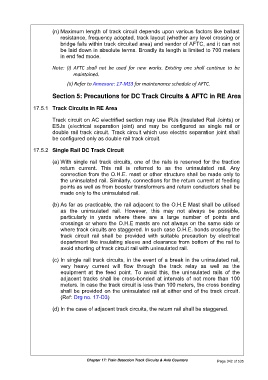Page 394 - IRSEM_Main Book
P. 394
(n) Maximum length of track circuit depends upon various factors like ballast
resistance, frequency adopted, track layout (whether any level crossing or
bridge falls within track circuited area) and vendor of AFTC, and it can not
be laid down in absolute terms. Broadly its length is limited to 700 meters
in end fed mode.
Note: (i) AFTC shall not be used for new works. Existing one shall continue to be
maintained.
(ii) Refer to Annexure: 17-MS3 for maintenance schedule of AFTC.
Section 5: Precautions for DC Track Circuits & AFTC in RE Area
17.5.1 Track Circuits in RE Area
Track circuit on AC electrified section may use IRJs (Insulated Rail Joints) or
ESJs (electrical separation joint) and may be configured as single rail or
double rail track circuit. Track circuit which use electric separation joint shall
be configured only as double rail track circuit.
17.5.2 Single Rail DC Track Circuit
(a) With single rail track circuits, one of the rails is reserved for the traction
return current. This rail is referred to as the uninsulated rail. Any
connection from the O.H.E. mast or other structure shall be made only to
the uninsulated rail. Similarly, connections for the return current at feeding
points as well as from booster transformers and return conductors shall be
made only to the uninsulated rail.
(b) As far as practicable, the rail adjacent to the O.H.E Mast shall be utilised
as the uninsulated rail. However, this may not always be possible,
particularly in yards where there are a large number of points and
crossings or where the O.H.E masts are not always on the same side or
where track circuits are staggered. In such case O.H.E. bonds crossing the
track circuit rail shall be provided with suitable precaution by electrical
department like insulating sleeve and clearance from bottom of the rail to
avoid shorting of track circuit rail with uninsulated rail.
(c) In single rail track circuits, in the event of a break in the uninsulated rail,
very heavy current will flow through the track relay as well as the
equipment at the feed point. To avoid this, the uninsulated rails of the
adjacent tracks shall be cross-bonded at intervals of not more than 100
meters. In case the track circuit is less than 100 meters, the cross bonding
shall be provided on the uninsulated rail at either end of the track circuit.
(Ref: Drg no. 17-D3)
(d) In the case of adjacent track circuits, the return rail shall be staggered.
Chapter 17: Train Detection Track Circuits & Axle Counters Page 342 of 535

